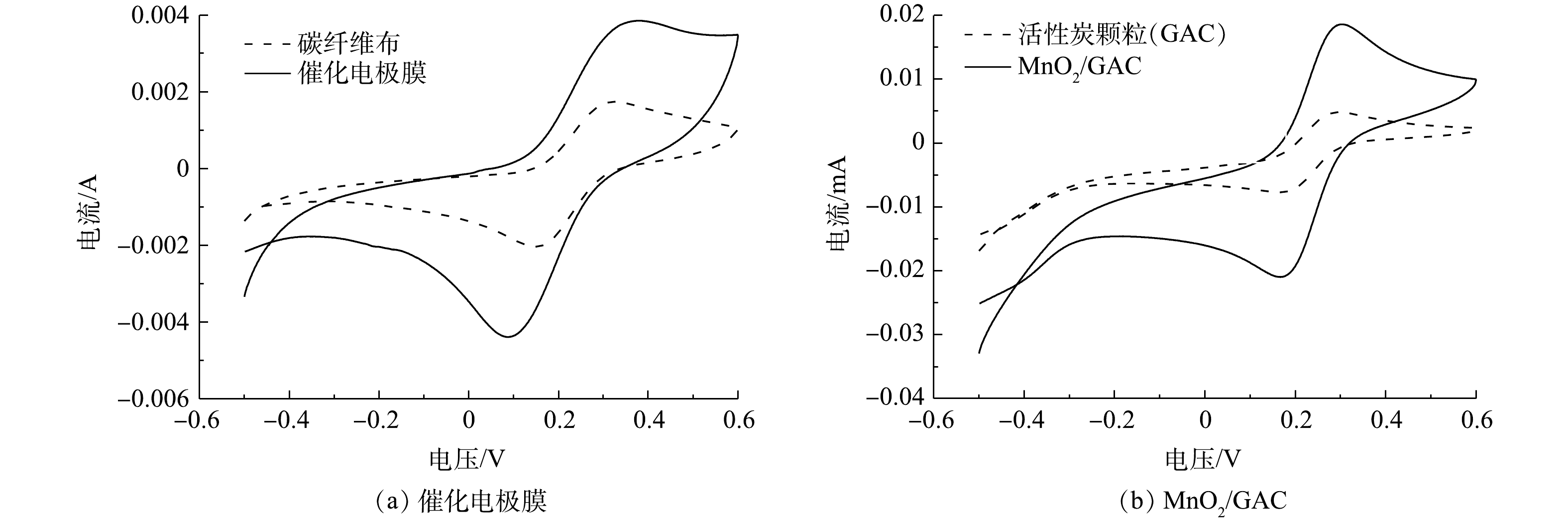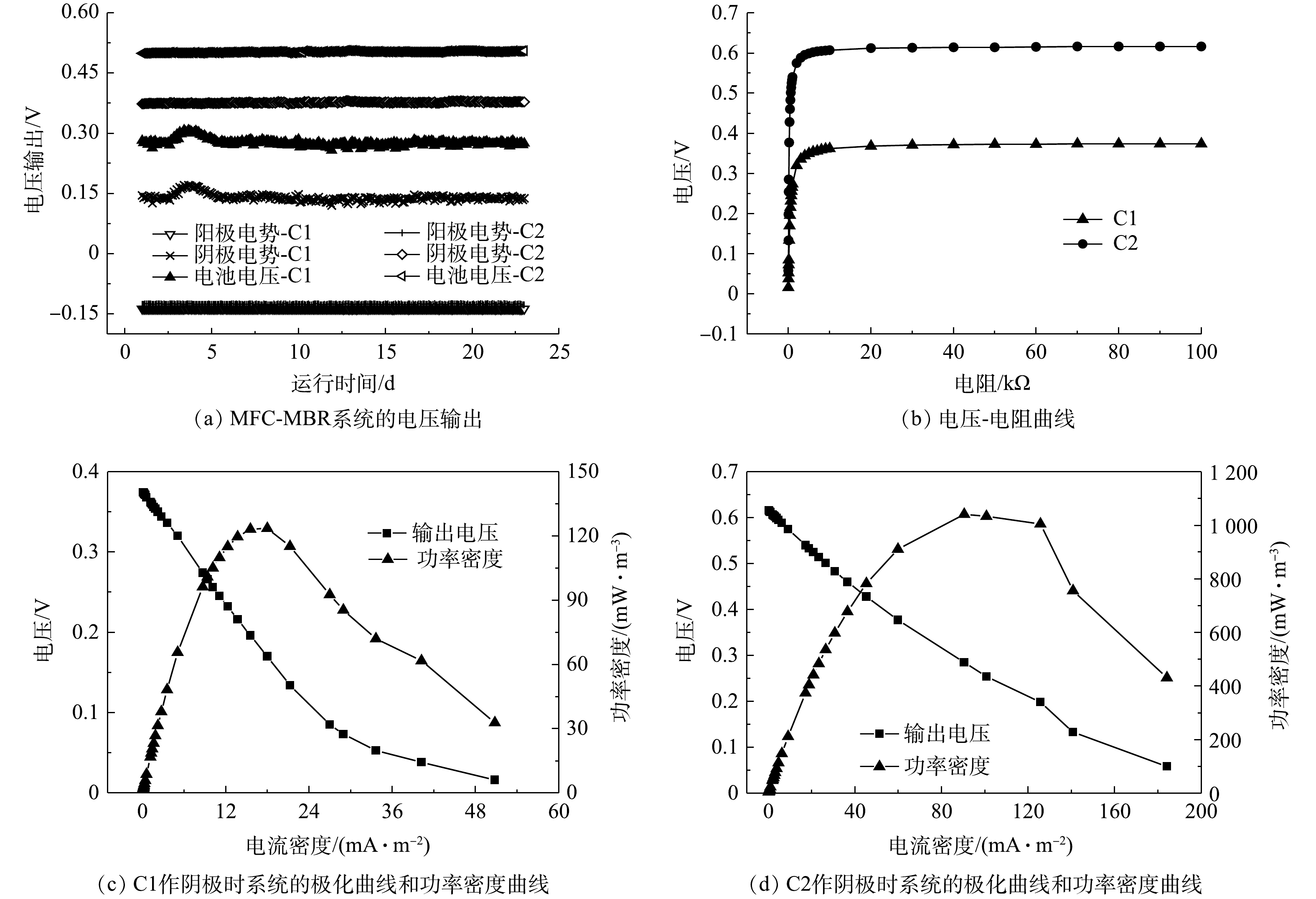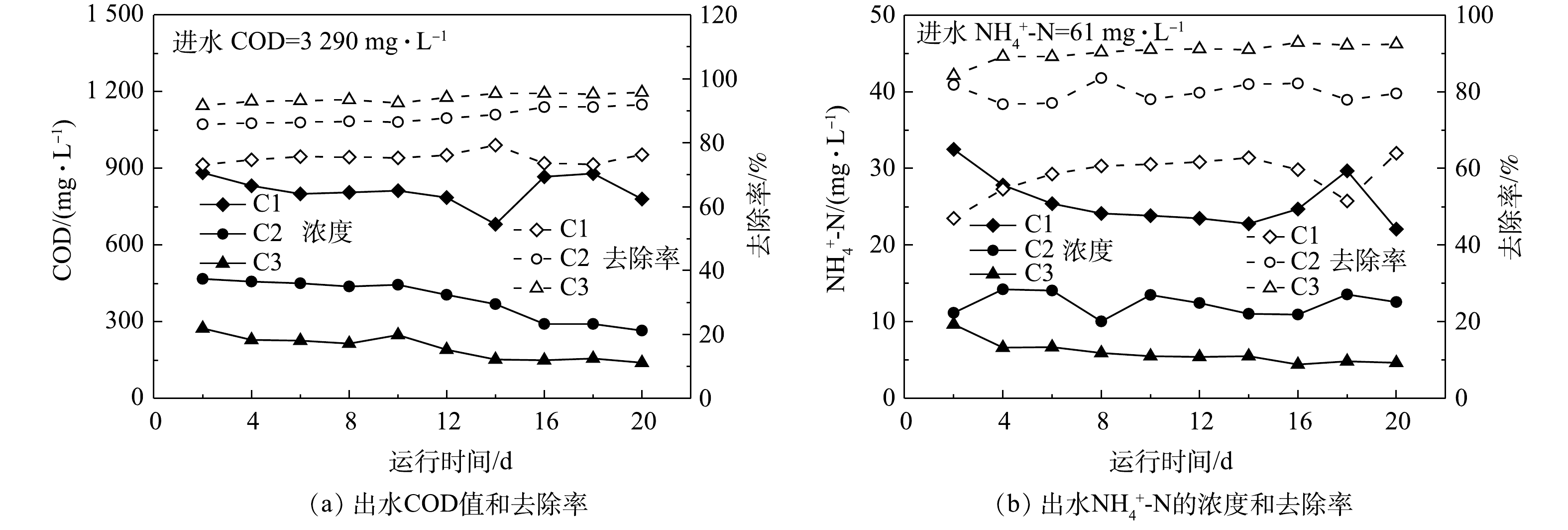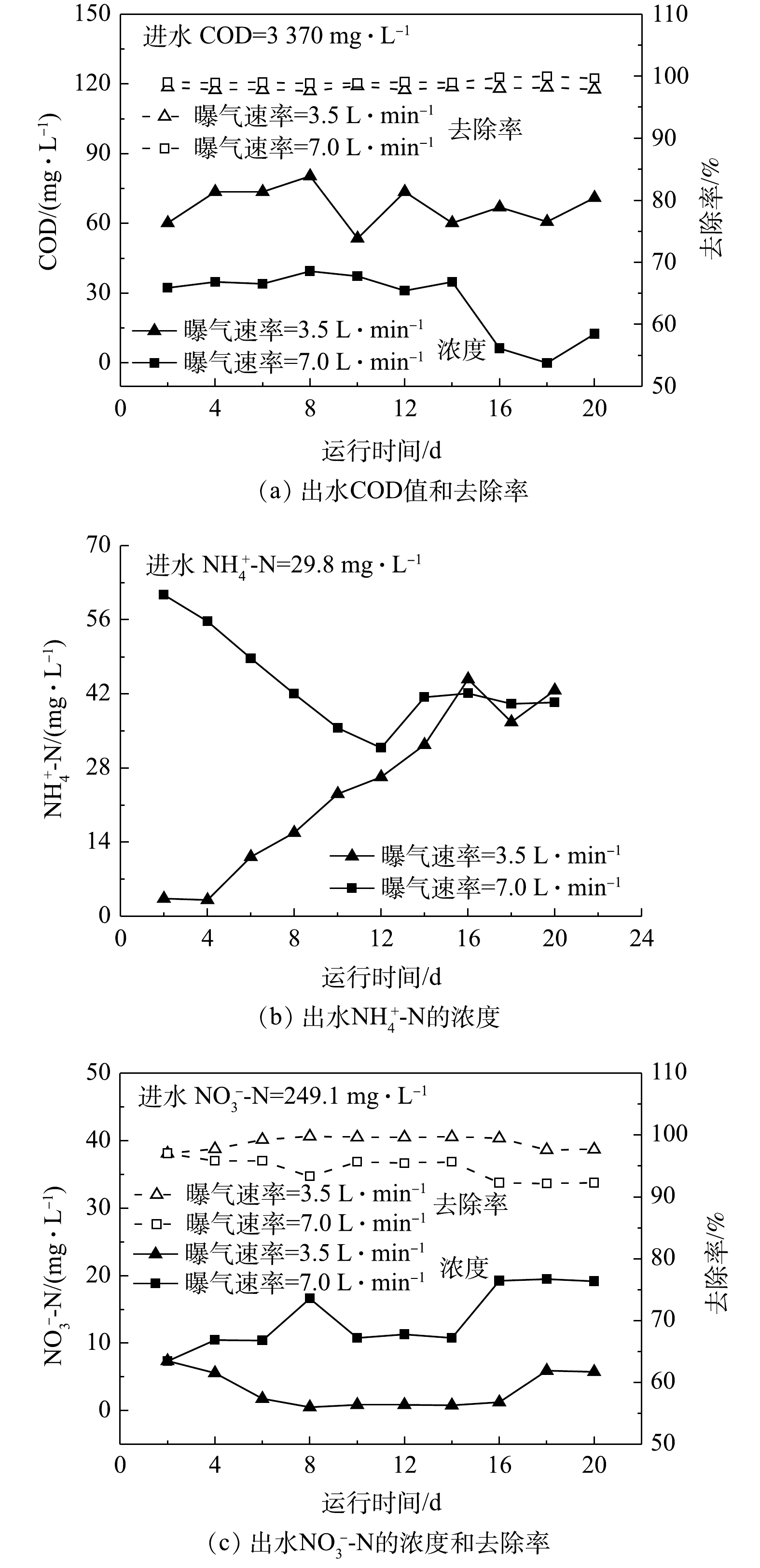-
人类对钢铁、焦炭的需求日益增长,导致煤化工炼焦行业产生大量高浓度的焦化废水[1]。焦化废水主要产生于煤炭高温碳化、煤气净化及其化工产品精制过程,是一类典型的有毒难处理工业废水[2],其成分非常复杂,含有高浓度的有毒无机污染物(如氨氮、硫化物、氰化物、氟化物等)和难降解有机污染物(如苯酚、多环芳烃、含氧、含硫、含氮杂环化合物等)[3-6]。焦化废水的难生物降解成分,具有高浓缩性、突变性和致癌性,经生物法处理后的废水中仍存在大量未知的有机化合物,需要进一步进行物化处理[7]。在焦化废水高级氧化处理方法中,臭氧氧化法和超临界氧化法操作难度大、成本高;Fe/C法填料易钝化,容易造成堵塞,对生化出水达标产生不利影响[3, 8]。因此,研发技术可行,经济有效的焦化废水处理方法迫在眉睫。
电化学水处理技术在近年来受到广泛的关注,因其具有反应效率高、速度快、操作简便、避免二次污染等优点,在废水再生处理领域具有广阔的应用前景[1, 9]。微生物燃料电池技术(microbial fuel cell, MFC)是一种将生物技术和电化学技术相结合的生物电化学技术[10],用于废水处理有望有效缓解当前的水资源和能源危机[11-12]。MFC在处理废水的过程中同时完成有机物的氧化分解、电子移动和产电,将污染物中的能量直接转化为电能,实现变废为宝,具有很高的能量转化效率,且不产生新的污染物,对环境友好[13-15]。此外,MFC对进水COD值适应范围广,具有抗污染负荷高,启动时间短,能耗低等优点[16]。尽管MFC还存在处理效率低、出水水质不达标等缺点,但通过耦合其他的水处理技术(如膜生物反应器,membrane bioreactor, MBR)[17-18]并选择更高效的催化电极[19],可以很好地解决这些问题。其中,合适的阴极材料和催化剂不仅可以提高阴极氧还原反应速率,而且能有效地提升出水水质和系统产电输出功率[20-21]。这将会是一个实现节能高效处理难降解工业废水的重要出路。
在本研究中,为降低内阻、提高产电和水处理效率,采用相转化法制备了新的催化电极膜,并通过原位生长法在活性炭颗粒表面和孔道内部负载MnO2,在上流式结构的MFC与MBR耦合反应器中,将包裹活性炭颗粒的催化电极膜作为MFC的阴极和MBR的过滤组件,对处理焦化废水的效果和产电能力进行了考察。
全文HTML
-
碳纤维布(carbon fiber cloth, CFC,240 g·m−2),购于宜兴瑞邦高性能纤维制品厂;聚偏氟乙烯(polyvinylidene fluoride, PVDF,FR904),购于上海3F公司;N-甲基吡咯烷酮(dimethylformamide, DMF,分析纯),购于天津市博迪化工股份有限公司;聚乙烯吡咯烷酮(polyvinyl pyrrolidone, PVP,分析纯),购于西陇化工股份有限公司;碳纳米纤维(10~30 μm),购于北京德科岛金;高锰酸钾(KMnO4,分析纯),购于大连化学试剂厂;二氧化钛/钴-三氧化钨-碳化硅催化剂(TiO2/Co-WO3-SiC),实验室制备[22];活性炭颗粒(granular activated carbon, GAC,0.8~1 mm),锰砂(0.5~1 mm)、石英砂(0.5~1 mm),均购于巩义市夹津口绿邦净水材料厂;氮气(N2,99.9%),购于大连光明气体研究院。
-
采用相转化法制备电极膜,铸膜液组成包括5% TiO2/Co-WO3-SiC催化剂、2.67%碳纳米纤维、6.67% PVDF、2.67% PVP和83%DMF。碳纳米纤维和催化剂分别用于提高膜的电导率和催化活性。将所有组分按比例加入烧杯后,经磁力搅拌6 h,转速约为350 r·min−1,然后超声脱泡。最后将铸膜液均匀刮涂在碳纤维布上,厚度为370 μm,快速放入去离子水中进行相转化6 h以上。经相转化获得的催化电极膜相比纯碳纤维布,表面明显形成一层深灰色的膜。
-
将活性炭颗粒浸泡在0.05 mol·L−1的高锰酸钾溶液中3 h,取出后用去离子水冲洗干净并干燥,然后置于管式炉中于350 ℃下煅烧3 h,期间持续通入氮气。最后取出并洗涤干燥,得到MnO2/GAC[23]。
-
反应器结构如图1所示。反应装置外壳为单室聚氯乙烯(PVC)材质的方盒,尺寸为34 cm×19 cm×23 cm。下层填充负载了产电微生物的活性炭颗粒作为生物阳极,填充高度约为12 cm,填充率约为90%。中间为多介质仓,将阴极和阳极分开,功能上可代替质子交换膜,降低成本并延长使用寿命,同时可以截留大颗粒物质,由1∶1的石英砂和锰砂构成,填充率约为95%,厚度为1.5 cm。上层放置膜组件作为阴极,膜组件上下为催化电极膜,2片膜的有效面积均为10.5 cm×15 cm,中间包裹活性炭颗粒(约100 g)。活性炭颗粒一方面可以起到支撑电极膜的作用,另一方面废水经膜过滤出水前,需先经过活性炭颗粒,部分污染物会被吸附和降解。溢流装置设在距反应器顶端5 cm处。进水约14 d后,出水水质及阳极电势基本稳定,微生物经驯化完成,同时活性炭颗粒吸附达到饱和。本研究共处理了2种呈碱性的、未经过预处理的原焦化废水,其基本成分和浓度见表1。第1种焦化废水(简称CW1)的处理共经历了3个阶段,分别采用不同的阴极:无催化剂的纯碳纤维布包裹纯活性炭颗粒(C1);催化电极膜包裹纯活性炭颗粒(C2);催化电极膜包裹负载二氧化锰的活性炭颗粒(C3)。第2种焦化废水(简称CW2)在采用C3为阴极时进行处理,期间改变阴极曝气速率。反应器采用连续进水的运行模式,水力停留时间为48 h。
-
采用扫描电子显微镜(scanning electron microscope, SEM)(NOVA NANOSEM 450,美国)表征并比较MnO2/GAC和GAC的微观形貌。在SEM表征期间,使用能量色散X射线检测器(energy dispersive X-ray detector, EDX)测量MnO2/GAC和GAC的元素组成和分布。
-
通过循环伏安曲线(cyclic voltammetry curve, CV)测量催化电极膜和MnO2/GAC的催化性能。使用三电极系统和恒电位仪,在0.005 mol·L−1的铁氰化钾溶液中进行测试。电位为−0.5~0.6 V,扫描速率为50 mV·s−1。使用数据采集系统收集MFC-MBR耦合系统的电压输出。通过梯度电阻法测量极化曲线和功率密度曲线。系统保持开路状态2 h以上,在阳极和膜阴极之间接入变阻箱,形成新的闭合回路。每5 min记录1系统的稳定电压,可变电阻箱从10 Ω依次变至99 999.9 Ω。在每次改变条件后,第4天开始取出水水样,每2 d取1次,1式3份,采用国标法测量其COD值和
NH+4 -N浓度,取平均值记录。采用紫外分光光度计,在254 nm处测量水样的吸光度值并记录。每次更换阴极或进水后,从第4天开始取样。
1.1. 主要原料和试剂
1.2. 催化电极膜的制备
1.3. 在活性炭颗粒上负载二氧化锰(MnO2/GAC)
1.4. 反应器的构建与运行
1.5. MnO2/GAC的表征
1.6. 电化学测试和水质分析
-
采用扫描电镜观察了MnO2/GAC制备过程中的微观形貌变化,如图2所示。可以看出,GAC和MnO2/GAC表面结构有着显着差异。纯GAC的表面粗糙且不平整,而MnO2/GAC表面有一层均匀分散的颗粒物,这说明MnO2均匀地负载到了GAC的表面上。EDX分析结果见表2,Mn元素在MnO2/GAC中的重量百分比大于8%(在GAC中为0%),这也证明了MnO2已成功负载到GAC上。
-
电极在铁氰化钾溶液中测得的CV曲线如图3所示。与无催化剂的纯碳纤维布相比,本研究制备的催化电极膜的氧化还原催化活性更高,其对应的还原峰电位约为0.091 V,且对应电流响应值较大。类似地,在活性炭颗粒上负载二氧化锰后,其氧化还原活性明显增高,在0.167 V左右有1个明显的还原峰。以上结果说明,本研究中制备的催化电极膜和MnO2/GAC均具有较高的电催化活性。
-
系统的产电性能见图4。系统的电压输出如图4(a)所示。在采用不同阴极时,阳极电势输出均保持稳定且电势值基本相同,这说明体系中的产电微生物生长状况良好且较为稳定,不同条件对电池电压的影响可忽略不计。采用催化电极膜包裹纯活性炭颗粒(C2)做阴极时,电池电压在0.50 V左右,比无催化剂的纯碳纤维布包裹纯活性炭颗粒(C1)为阴极时平均高出0.22 V,这说明制备的催化电极膜相比无催化剂的纯碳纤维布具有更高的电催化活性。阴极电势的变化趋势与系统电池电压一致,而阴极电势主要受系统阴极催化活性的影响。这也表明阴极的电催化活性可进一步影响电池电压。
分别采用C1、C2作为MFC-MBR系统的阴极时,体系开路电压分别为0.375 V和0.616 V,C2比C1高出64.27%(图4(b))。当C1作阴极时,体系最大功率密度为123.50 mW·m−3,对应电流密度为17.99 mA·m−2;当C2作阴极时,体系最大功率密度为1 041.35 mW·m−3,对应电流密度为90.48 mA·m−2,比C1增加了7倍多。催化电极膜具有良好的导电性和催化活性,可以加速界面反应速率,降低反应所需的活化能,从而提高了MFC-MBR系统的产电功率密度。在2种情况下,体系的内阻分别为309 Ω和104 Ω,比同体积的微生物燃料电池体系内阻明显要小。这说明无质子交换膜的上下结构的微生物燃料电池具有更小的内阻,可以有效减少系统内部能量损耗。采用催化电极膜包裹纯活性炭颗粒为阴极时,可以获得更高的功率密度和更小的内阻,从而减少内部能量损耗,提高能量回收效率。以上结果表明,本研究制备的催化电极膜有助于改善MFC-MBR系统的产电性能。
-
如图5所示,以第1种焦化废水为进水时(COD≈3 290 mg·L−1,图5(a)),采用C1为阴极,出水COD值平均高于800 mg·L−1,去除率低于80%。采用C2做阴极时,COD去除效果明显提高,COD去除率最高可达92%,最低不低于85%,出水COD值最低可达265 mg·L−1。这说明催化电极膜包裹纯活性炭颗粒(C2)做阴极对焦化废水中污染物的去除起到有效的作用。
当采用催化电极膜包裹负载二氧化锰的活性炭颗粒(C3)做阴极时,出水COD值明显降低,最低可达140 mg·L−1,且出水浓度随反应器运行时间的增加呈下降趋势。COD去除效率最高可达到95.75%,COD去除负荷为1.55 kg·(m3·d)−1,比C1、C2做阴极时分别提高了25%和7%。这说明,在活性炭颗粒上负载二氧化锰有效提高催化活性,增强对污染物的去除能力。
图5(b)为
NH+4 -N出水浓度和去除率(进水为第1种焦化废水,NH+4 -N≈61 mg·L−1)的变化情况,结果与COD去除效果相似。当使用3种不同阴极时,出水NH+4 -N平均值分别为25.63、12.34和5.91 mg·L−1,最大去除率分别为63.96%、83.61%和92.81%。这说明制备的催化电极膜和MnO2/GAC对NH+4 -N的去除均起到促进作用。氨氮在好氧条件下被硝化细菌转化为硝酸盐或者亚硝酸盐,而催化电极膜和MnO2/GAC不仅有效增加阴极界面催化反应面积,而且增大阴极微生物附着面积,且活性炭颗粒表面和空隙内部粗糙,更易于微生物附着和作用。有研究[23]表明,阴极填充活性炭颗粒有效提高NH+4 -N的去除,在控制通气的情况下,使MFC阴极室内不同位置存在好氧和缺氧区域,可同时发生硝化反硝化作用。以第2种焦化废水为进水时(COD≈3 370 mg·L−1),采用催化电极膜包裹负载二氧化锰的活性炭颗粒(C3)做阴极。控制阴极曝气速率,出水COD值和去除率的变化情况如图6(a)所示。由图6(a)可以看出,对比第1种焦化废水,第2种焦化废水初始COD值略高,但在相同的处理条件下,第2种焦化废水经处理后的出水中COD值更低,去除率更高,这说明系统后期对第2种焦化废水的处理相对更容易。当曝气速率为3.5 L·min−1时,出水COD值平均为67.41 mg·L−1,COD去除负荷为1.65 kg·(m3·d)−1;当增大曝气速率到7.0 L·min−1(2个曝气泵)时,出水COD值均低于40 mg·L−1,达到废水排放标准,去除率均超过98%,COD去除负荷达到1.67 kg·(m3·d)−1。出水UV254分别从进水的23.80 cm−1减小到0.147 cm−1和0.074 cm−1。以上结果说明,适当增大阴极曝气量,增加阴极溶解氧浓度,使其不再是氧还原(ORR)反应的限制条件,将有助于污染物的去除。
如图6(b)所示,在处理第2种焦化废水过程中,出水中
NH+4 -N的浓度高于进水,这是因为焦化废水中的含氮有机物在降解的过程中,分解产生NH+4 -N,且相应的耗氧有机污染物(以COD计)降解越多,分解产生的NH+4 -N可能也越多。这部分NH+4 -N未被完全降解而累积,因此,导致出水中NH+4 -N浓度高于进水的浓度。所以,随曝气速率增大,出水中NH+4 -N浓度虽然相对前一阶段要高,但这并不能说明溶解氧增加会影响NH+4 -N降解,相反曝气量增加促进ORR反应和硝化作用,同时加速气提脱氮作用,可提高NH+4 -N去除率。增大曝气速率,耗氧有机污染物降解量增加,随之产生的
NH+4 -N也增多,NH+4 -N在阴极室降解过程中产生NO−3 -N。进水中含有高浓度的NO−3 -N,再加上NH+4 -N转化的部分,系统去除NO−3 -N含量始终高于230 mg·L−1。如图6(c)所示,增加曝气速率,出水NO−3 -N略有增高,可能是由于NH+4 -N在阴极室降解产生的NO−3 -N量增加造成的,但相对于进水,NO−3 -N去除率始终高于92%。
2.1. MnO2/GAC的形貌表征分析
2.2. 催化电极的催化活性分析
2.3. 产电性能分析
2.4. 废水处理效果
-
1)使用具有不同阴极的耦合体系处理同种焦化废水,在催化电极膜内,放置负载二氧化锰的活性炭颗粒,采用这种阴极的耦合体系对水处理的性能最优。
2)采用催化电极膜内置活性炭颗粒作阴极的耦合体系处理焦化废水,其最大功率密度为1 041.35 mW·m−3,比对照组提高了7.4倍。
3)使用催化电极膜内置MnO2/GAC作为MFC阴极处理2种焦化废水(CW1和CW2):对CW1中的COD和
NH+4 -N的去除率最高可达95.75%和92.81%,对CW2中的COD的去除率最高可达99.79%;对CW1和CW2中COD去除负荷分别为1.55 kg·(m3·d)−1和1.67 kg·(m3·d)−1,增大阴极曝气速率可提高COD的去除率。







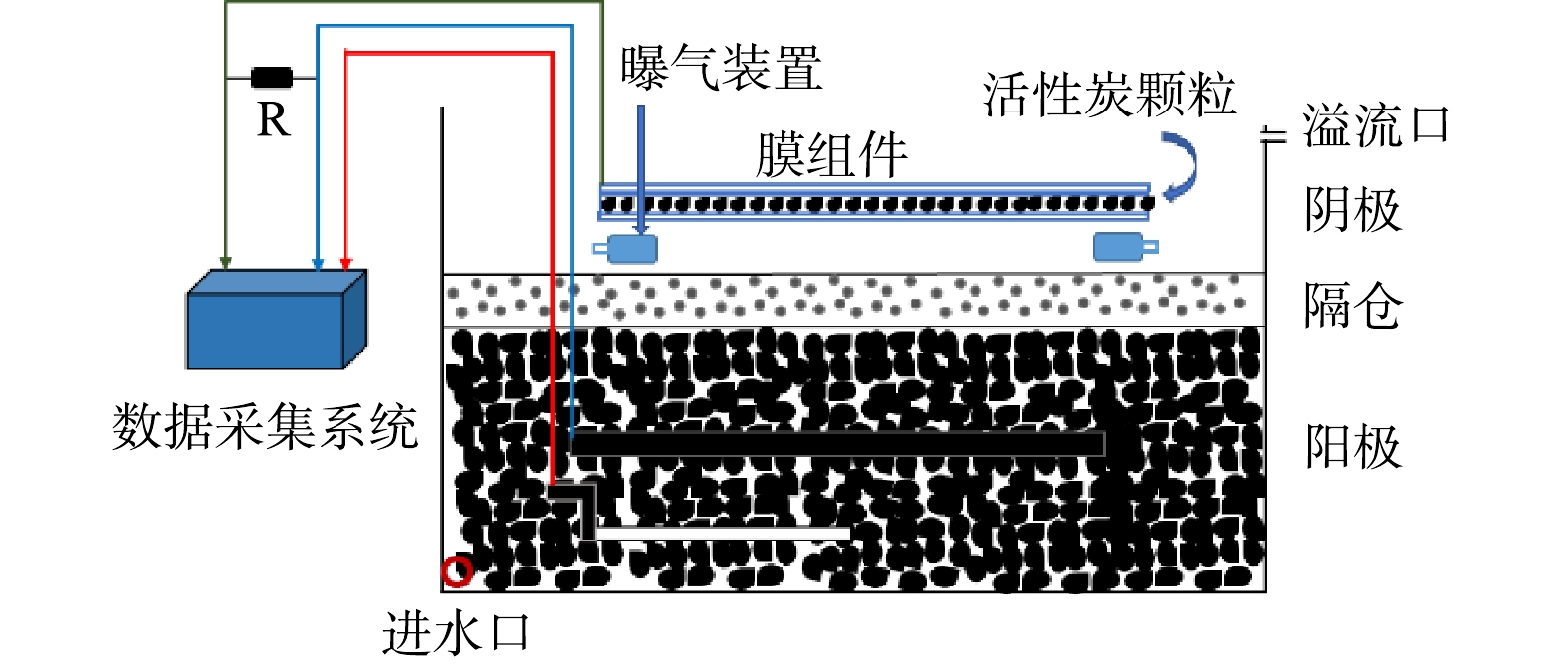
 下载:
下载:






